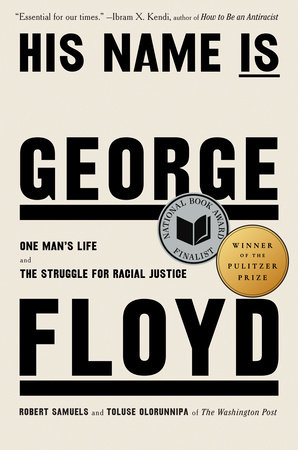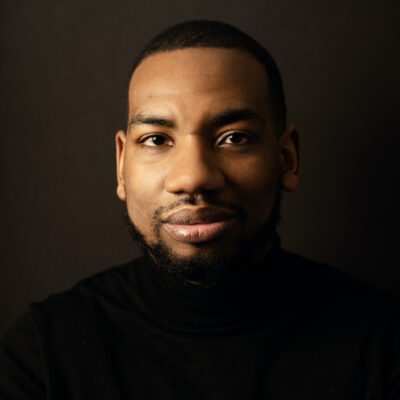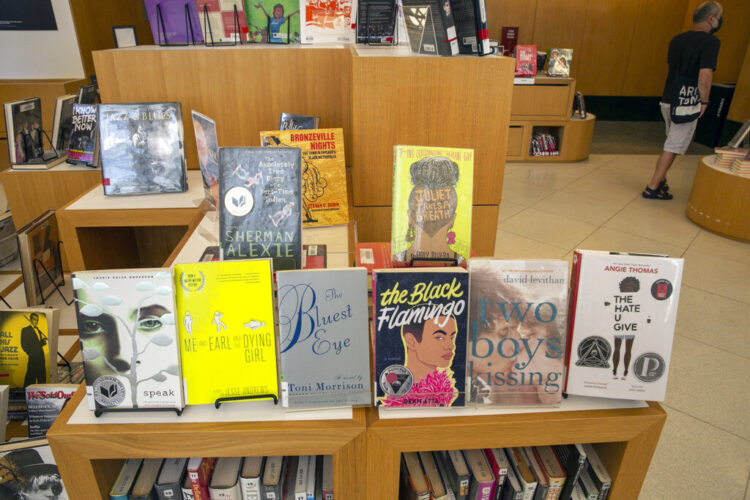Imagine that you’ve reached your long-held journalism dreams. You worked your way to the staff of a big masthead newspaper. Then you moved beyond the breakneck pace and tight word-count limits of that world to the relative luxury of long-form magazine narratives. Then the pinnacle: a book.
Now imagine that your book, which is based on all the work you’ve done before, is banned. Your work has become one more casualty of the current culture wars.

For Washington, D.C.-based reporter Robert Samuels, that journey is no longer imagined. Samuels was covering America’s “changing identity” at The Washington post when George Floyd was killed under the knee of a Minneapolis cop in May 2020; Samuels was on the team that reported an award-winning series on the murder. (The series, “George Floyd’s America,” was featured in two Storyboard posts, one with Samuels and one with then-editor Steven Ginsberg.) Samuels then teamed with colleague Toluse Olorunnipa on the 2022 book, “His Name is George Floyd: One Man’s Life and Struggle for Racial Justice,” which won the Pulitzer Prize for general non-fiction and was a finalist for a National Book Award. In March 2023, Samuels joined The New Yorker as a staff writer.
And in November 2023, Samuels wrote about learning that the George Floyd biography had been banned by a high school in Memphis, Tennessee, under the state’s new “Critical Race Theory/Age Appropriate Materials Law.”
The chain of events is non-linear, as are the claims and counterclaims by various school officials. In brief, Samuels and Olorunnipa had been invited to Memphis by organizations involved in a city-wide reading program. Their visit included a talk at Whitehaven High School, a public school with a majority Black student population. Before the visit, they were told there restrictions on what could and could not be read from the book or discussed in a presentation to students. According to Samuels’ essay:
(A school official) insisted that we discuss “gentler topics.” We were told not to connect policies of the past with contemporary racial disparities and to avoid “anything systemic.”
In his New Yorker piece, Samuels delves a bit into his own childhood in the Bronx. He was 14 when Amadou Diallo was killed during a stop by New York City police. His takeaway at the time:
Innocent black man. Shot forty-one times. A simple misunderstanding that could get you killed.
At the same time, he was introduced to a deeper understanding of the Black experience in America through teachers who introduced him to Black authors:
I had once been told that the answer to anything could be found in a book.
Now he found the book he had written with Olorunnipa, the Post’s White House bureau chief, closed to young minds that probably were as hungry for knowledge as his had been. The realization, he wrote, was “heartbreaking.”
In a conversation with Storyboard, Samuels described his motivations for writing about having his book banned, and what he learned about the different challenges of writing for newspapers, magazines and non-fiction books. The Q&A has been lightly edited for length and clarity.
What prompted you to write your most recent essay for The New Yorker about the experience of your book being banned?
Learning the book was banned was horrifying. There’s a lot of mythology about how books get banned, who bans the books and what it does for an author. Some people see it as a badge of honor or sign they’ve done something well. But all I could think of was the fact that these students are prohibited from reading our book. I felt it was important to tell that story so people could understand what the stakes are. A million liberals — and people who don’t need to be convinced about some of the content or concepts in the book — do not make up for the fact that high schoolers, at a very vulnerable time in their lives, will not get the chance to read it.
There’s a lot of mythology about how books get banned, who bans the books and what it does for an author. Some people see it as a badge of honor or sign they’ve done something well. But all I could think of was the fact that these students are prohibited from reading our book.
What were you hoping to achieve with this essay?
Like so many writers, it was important to my spirit to be able to just write it down. It was therapeutic for me. I also hoped people would gain a more fulsome understanding of how this is happening and the reverberating effects of it. This was not a conservative, white government that did this, but a fairly democratic school district that’s predominantly Black. They have to deal with living in a state that can be pretty vindictive about racial issues. I thought it was important for that to enter the conversation. It’s so easy to simplify, but I wanted people to see the complicated mess of the state of books and journalism that we’re in.
What has the response been like to your piece? Do you think it did what you wanted it to do, and how do you gauge that in the first place?
When I was working at The Washington Post, a reporter’s email was shared on the article so it was easier to get a sense of the response right away. At The New Yorker, my email address isn’t connected to the article. I was glad to see that readers shared in their sadness and confusion about it. But how it furthers the conversation — we’ll just have to wait and see.
At the very least, the idea that we were able to have this conversation in a public manner prompted the school district to reconsider their stance. Another thing that’s important here is that an intrepid reporter at Chalkbeat Tennessee, Laura Testino, had found this story before we did. I didn’t want to scoop her — I wanted her to be able to tell the story that she had enterprised. I was so glad that there was a local journalism culture there in which an education reporter was able to do that.
After Laura wrote her story, there was a lot of content aggregation based on a piece done by NBC News, but it was not as precise as the Chalkbeat story. By the time we wrote our piece, there was a good amount of discussion about what was happening in Memphis, and a good amount of manipulation and spin from the school district about what happened. I was glad to be able to set the record straight and redirect the conversation to where it needs to be: If you are in one of these school districts and might feel the wrath of a larger government that sees ‘acceptable books’ in a different way than your local government does, what happens? There are real effects that emerge when a school district is strapped on cash and needs approval from their state government. They have to make really tough choices. I’m glad that the conversation moved toward that end, as opposed to trying to beat up on Ron DeSantis again.

You’ve gone from doing enterprise work at a legacy paper like The Washington Post to The New Yorker — which is very much a narrative magazine — to writing a book. What kinds of different muscles have you had to develop in each environment?
Writing for The Washington Post feels like you’re writing a very tightly knit ball out of rubber bands. It has to move forward as efficiently as possible and you need to make different decisions about the details you use. The New Yorker feels more like a ball of yarn that gets pulled by a cat. It moves a little bit more slowly. One detail has to follow the other detail, but there’s more willingness for rumination.
Writing the book felt more freeing than either newspapers or magazines. You get to make choices about pacing, structure and context. You are creating a world for people. That world only exists in the pages of the book. Whereas even at a place like The New Yorker, you’re writing in the context of a reader battling between you and other interesting things inside the same magazine or website. With a book, you can be more expansive — and in that expansion, you can actually be more decisive. You don’t owe anyone a nut graf or a “to be sure,” paragraph that acknowledges some other perspective. You’re not writing for a particular publication with a particular style. You have to decide what feels most natural and honors the work. Whether the reader stays engaged is completely on your shoulders.
How do those formats — writing the rubber bands, the yarn, the whole world — push you to develop different skills?
Newspapers require efficiency and contextual wisdom. How much can I put into this story with as few words as possible, recognizing that the person only gives me a couple seconds? For a magazine, it’s sort of like: How much can I get away with? You still have to make decisions, but it’s looser in terms of word count and there’s more of a feeling that that natural chronology is key.
When formulating stories for The Post, the most important sections or nut grafs would come around the 25% to 30% mark in a story. The takeaway or emotional meaning of the piece would come somewhere between the 60% and 75% mark.
Magazine pieces are more casual about it, even if the main thrust or emotional punch still appears around the 70% to 75% mark. The muscle I’ve had to learn working at The New Yorker is trusting that the reader will stay with me as long as I’m captivating.
With a book, each chapter needs to earn its worth. Each sentence needs to earn its worth.
With a book, each chapter needs to earn its worth. Each sentence needs to earn its worth. You write a book not so much in the immediate context of what’s going on in the world, but rather, what the main themes of the book are. At the 25% to 30% mark of any chapter, you want to introduce a theme that links it to the previous and following chapters. But who knows when you get to the main thrust of a book? We probably didn’t get to it until three or four paragraphs from the end. It’s very different.
What do you mean when you say the context is different?
If I was writing about a book ban in a newspaper, I would think, ‘What other stories have been written about book bans? How is this one different? How does this relate to other things that might share the page with this story?’ Magazine pieces are a lot more isolated so a person is making a choice to read it because they think it’s interesting. When you write your nut graf, your proof is like, ‘This is interesting, stay with me,’ as opposed to, ‘There are six stories on this page and you need to choose one.’
To flip my original question on its head, how do you see these story forms — newspaper, magazine, book — as fundamentally similar?
Every sentence has to earn its place. Language can’t be wasted. When we first started writing the book, I had a lot of notes on extended dialogue from scenes in the original stories for The Washington Post that I thought were super interesting, but weren’t relevant for the newspaper story. I thought they could be relevant here. But then I’d realize, ‘No, we didn’t make this decision simply because there was no space. We made this decision because the extended dialogue actually doesn’t work. It doesn’t add anything.’ There’s a mythology that when you write a book, it’s like writing the story you wanted to write without your editors saying you have to cut it down. But all of those things still apply.
The other mythology is that a book is like writing 10 magazine pieces and putting them together. It’s not.
The other mythology is that a book is like writing 10 magazine pieces and putting them together. It’s not. Even with magazines, you still have to exercise discipline. Just because you could write 8,000 words on a topic doesn’t mean you necessarily should. From a reporting perspective, in both books and newspapers, you want to do it all yourself. In a magazine, it’s a little less necessary for you to re-report other people’s reporting. There’s a lot more trust that other reputable newspapers have done it correctly.
What was the steepest part of the learning curve in terms of transitioning to book writing?
I think the steepest part was holding multiple threads at the same time. When you’re doing an individual story, you do your reporting and live with it; after a couple of weeks, you’re on to the next thing. With a book, you have to hold a much more sprawling narrative and outline in your head. That’s hard. We wrote the book with the same standards and deals we’d made with sources at The Post, which was: If something happens and a source, or a character, decides this project is not for them anymore, they can pull out. But managing sources is a different calculation for projects that will be turned around in a week or two, as opposed to in a year. It’s hard to take people who have taken a risk by talking to you in the first place — and try to maintain a relationship with them so they still believe it’s the right thing to do — over a longer period.
How do you pressure test an idea to determine if it’s worthwhile to pursue as a long-term project for a magazine or even a book?
I’m still learning that. For me, the first thing is: What fascinates me about it? Is this something that I can really wrestle with and have different opinions on. Can I find different facets to unpeel the onion? Is each part of that interesting? That makes me feel like we can sit with this for an extended period of time because my innate sense of curiosity will lead the way. I’m fortunate enough to still find lots of things interesting.
Every editor I’ve ever worked with will say that’s both a good and bad thing in terms of me wrapping things up.
Who did you want to reach with your book, and how was that target audience different from The Post readers who were following the newspaper’s coverage of George Floyd?
With the original series, we really tried to make it feel like there was something for everyone. A lot of times when we write about issues of race and racism, we think about it as helping white people. You imagine the well-meaning but ignorant white person who is willing to be educated.
When we talked about conceiving the book, there were a few target audiences I wanted to hit. I thought about myself as a 16-year-old and then about my friends’ kids — many of whom are between infancy and four years old, and are Black or kids of color. I wanted them to someday be able to think about this moment they’d heard about and grab something that felt contemporaneous and real. I wanted them to have the opportunity I didn’t have when I was a teenager.
I also thought about all of the people who would hear about this topic and think it would be too depressing, or that it would be some way to martyr a person who shouldn’t be martyred, or people who don’t believe racism exists. I wanted the book to be a challenge for them. If they had a friend or a teacher who was like, ‘Listen, challenge what you know,’ they could pick up the book and feel that some of these theoretical topics are very real and have tangible effects.
How have the public-facing and promotional aspects of book sales been for you?
I’m fairly extroverted, yet even for me it’s been really hard. Social media has changed this a little bit, but generally speaking, journalists are not usually in a position of promoting ourselves the same way we have to for books. We’re not used to constantly asking people to pick our work up. It’s uncomfortable.
We were also trafficking in really tough, emotional topics with this book. So many times we’ve gone out and talked about it, and I’ve had to stop myself from crying. People ask for tips for how to prevent their kid from being shot by a police officer. People want to share their own incidents.
The flip side of that is that it’s also incredibly rewarding to connect with people who have taken the time to come see you, read your work and have an in-person discussion about what moves them. You’d never get that interaction in daily journalism. Book readers are also a lot nicer and more appreciative than newspaper readers.
* * *
Carly Stern is an award-winning freelance reporter based in San Francisco who covers housing, disability policy, urban life and economic inequality.



